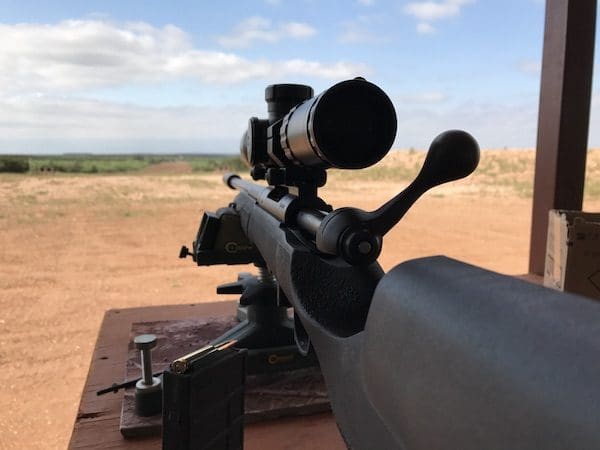
I recently shot a suppressed Savage precision rifle out to 1000 yards. It was a deeply satisfying experience. The sound of the gun’s report, the delay, the spotter’s call (HIT!) and the clank of the 6.5 Creedmoor bullet hitting metal. The NRA Outdoors instructors at the T Diamond ranch gave me three simple tips for newbies aiming to stretch their ballistic legs.
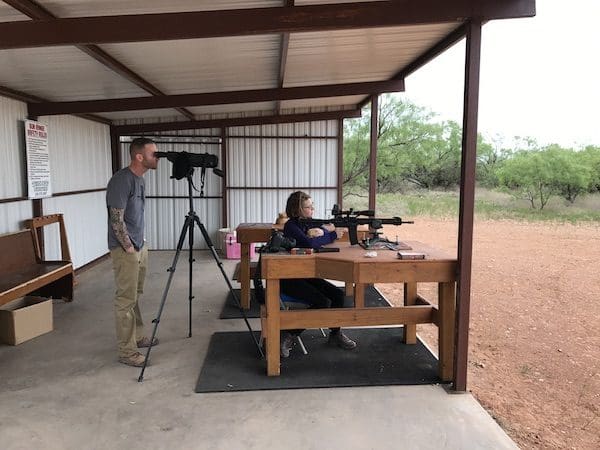
1. Spot!
When you squeeze the trigger of a precision rifle, the recoil can make it difficult to see your target. If you’re watching the shot from the spotting scope you can (usually) see exactly where the bullet hits, as it hits.
You can then call out the changes that the shooter must make to get his or her round on target. By doing so, you’re learning about mission critical variables, including the shooter’s skills, the rifle/bullet combination and, most importantly, wind.
All this without having to concentrate on the shooting variables: positioning, breathing and trigger press. And ego.
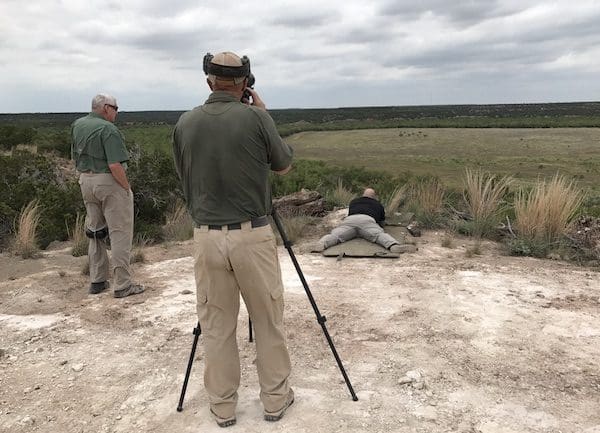
2. Be consistent
“Variables are the enemy,” the NRA Outdoors instructors told me. Copy that. The less variables you have when shooting long-range — gun, scope, ammo, trigger, environmentals, etc. — the greater the probability of hitting the target.
And here’s the thing: even if you’re doing something “wrong,” keep doing it! In other words, don’t get too hung-up on technique. Don’t constantly modify your equipment or technique. Above all, more than anything else, be consistent.
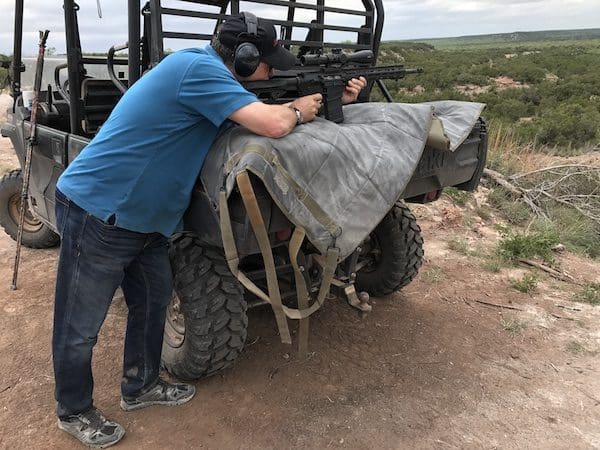
3. Get great instruction and practice!
To use the British expression, start as you mean to finish. As with most things ballistic, it’s a lot easier to learn good habits from the start than it is to modify bad habits.
The NRA Outdoors course in Hamlin, Texas (where I shot) costs $2,300 plus transportation. If you want to shoot long range, whether for ringing steel or ethical hunting, it’s worth every penny.
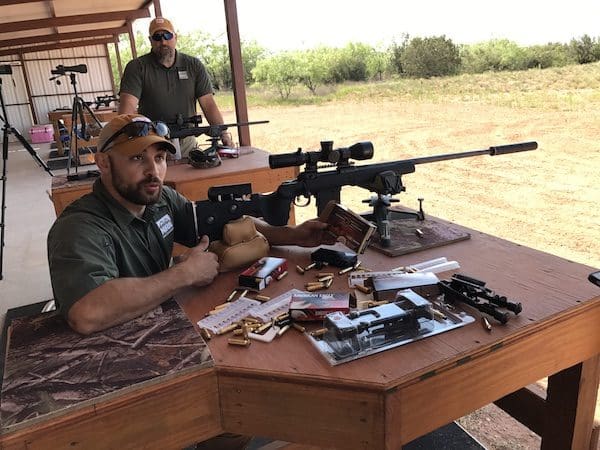
The NRA instructors were patient and understanding and excellent communicators. More than that, they taught a range of shooting positions on a variety of guns at a range specifically designed for long-range plinking and hunting. And not just sitting at a shooting bench.
One more thing: listen! I know that sounds obvious, but plenty of shooters show up to a long-range shooting class and assume they already know it all. Or prefer to use their time in a class schmoozing and telling stories. Don’t be that guy or gal.
Once you gain the right skills needed to shoot long range, practice. Again, I shouldn’t have to tell you that. But there are distance shooters and hunters who fail to realize that long range shooting is a frangible skill. Persistence — patience over time — is the key to success.




One may want to consider laying off the caffeine the day before, as well…
Guess I won’t be doing any serious long range shooting then.
It can impact different folks in different ways, but it is most certainly a thing.
The older I get I find it impacts me more. I was re-introduced to this recently when doing some very intricate printed circuit soldering. To the point I gave up that job for another day as I wasn’t interested in ruining that job.
If I had been trying to ring long range steel like that I doubt I would have been able. The fine tremors would have made it very difficult…
I think any shakiness I have would be more manageable than the fact that my eyesight is deteriorating. I could probably learn to hit targets farther out if only I could see them clearly. Optics can only do so much. Sucks getting old.
Nah, Caffeine calms me down and helps me focus.
If you have ADHD stimulants can work the opposite. Most ADHD medicine is actually a stimulant. Seems reversed I know but that’s brain chemistry for you.
I take no prescribed meds and I wouldn’t take ADHD amphetamine-type drugs anyways…
Chocolate coated coffee beans are a great depressant for severe ADHD individuals, for temporary use.
First rule for the safety of others: Do Not Let Me Miss My Coffee. I have to drink at least a pot before the birds sing or the sun comes up.
Let’s see…consistantly good technique(fundamentals) or consistantly poor technique? I’ll take the latter!
Don’t you mean “the former”?
Yep. Must have had too much caffeine!
Damn, $2300. Im going to have to come out of retirement and go back to work…teaching LR shooting. If i can do it, anyone can. The first thing is having the right eqpt. A 3006 and a 3×9 scope can do it but thats not what i would tell a newbie to buy.
Ode to the Spotter. . .
I don’t know of one, but there should be one.
This seems like a good course but $23,000.00 is a hard pill to swallow!
Everyone talks about the latest, greatest hot-rod rifle that lets them put hits on steel at 1K yards with boring regularity. No big deal that almost anyone can do when another sets up the rifle/scope/bullet combination, so long as the eyes and fingers hold up.
How about some articles on how to set up the bullet? Let’s delve into the mystery (and mystery it is to me!) of how to manufacture that super-accurate round at our reloading bench?
If you can follow directions, pay attention to detail, and follow a receipe you can reload. Start by buying a reloading manual and reading the opening chapters. That will give you a decent understanding of what you are doing and why you are doing it. After that you can get as advanced or as basic as you want. There are folks out there that are like mad scientists when it comes to reloading. Guys that will segregate their cases by weight, primers by weight ets, etc. Guys that can group sub MOA at ridiculous distances. Then there are folks that will simply work up a good load, stick with it and reload to a more basic level. Myself I am in the latter group. I can ding a 30″ gong at 1,000 yards consistently, I reload to factory spec and don’t really do anything super special. I don’t worry about groups, I figure consistent hits on a target that size is pretty decent. But then again distance shooting for me is a zen thing and truth be told I hate working brass and reloading. But I do it. If you put in the effort and use some advanced techniques you can create some seriously accurate stuff.
“…I reload to factory spec and don’t really do anything super special….”
That is my point. How does one get to ‘factory spec’? I’ve been trying to duplicate Federal’s Fusion load for my .308 and can’t even come close with all I’ve tried. (Yeah, whining a bit here. Or is it crying when there are crocodile tears?)
I’ve read my Hornady, Speer, Lyman, and Hodgdon manuals and others, chronographed loadings and burned a ‘ton’ of powder and still can’t get the groups close to Feds’.
So, next question: Where do you find ‘factory specs’?
Should have phrased it better. I meant the specs in the manuals. You can approximate by loading to listed velocity on the ammo box. Sorry for any confusion. A lot of factory ammo is loaded using blends of powder that are not available to reloaders (or at least that’s what they tell you). You can also measure factory ammo to get overall length, case length, etc and get close. Keep in mind that a reloader can produce ammo that is consistently more accurate than the factory stuff. A factory .308 round needs to fit ALL .308. A reloader can custom tailor rounds to their specific firearm through trial and error, adjusting seating depth, etc etc. Sorry for lack of clarity.
I haven’t shot the Fusion yet but I cloned GGM 168 on my first real attempt. Using good brass and Varget behind a 168 gr. SMK I matched velocity out of my .308 to FGGM. 2750 fps on both. With a little research on several of the long range boards most recipies for factory loadings can be found and are a great starting point. My clones are just as accurate as well.
>>How about some articles on how to set up the bullet?
6mmbr.com?
As a side note (regarding the photos),
Anyone who builds a range shelter out of bare metal walls and roof should be slapped upside the head. It makes a really loud experience even more louder.
Start with rough sawn lumber or OSB and put the metal roof on top of that. Better yet, cover the inside with spray foam or acoustic foam. The difference between shooting under a metal ceiling vs. a wood ceiling is night and day.
My advice from a very amateur longer range shooter is choose your setup wisely, learn the setup well, and treat it well.
In a day and age of sub moa rifles for under $500, decent glass for the same, and all the starting knowledge at your fingertips, you should be able to make a decent starting setup without selling your house. I generally just laugh when someone makes fun of my budget setup and I just think about how I’m not better than the rifle or glass yet. Maybe someday, but for now my setup isn’t holding me back.
#4: have somewhere you can practice! I live in Kansas, and one would think that with all the open space we have here there’d be plenty of long range rifle ranges, but I am aware of none. There are a couple of 100 yard ranges in the area and thats it. For the majority of shooters I would say the “just shoot on someone’s land” isn’t a viable option, and there is basically no federal BLM land here. I would really like to see some at least 500 yard ranges, open to the public, open in the area. As it is I am predominantly a handgun shooter since I mostly shoot indoors with 25 yd ranges.
Mill Creek Rifle Club has 300 yards and a 500yd that’s open at select times.
Why aren’t the spotters wearing ears in the first two photos?
Wait til the target is closer.
Comments are closed.